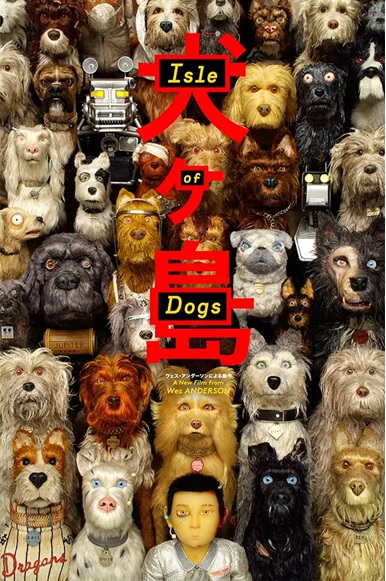
Courtesy of ‘Isle of Dogs’ Official Site
‘Isle of Dogs’ is a new Wes Anderson movie about a young Japanese boy that befriends exiled dogs on a quest for his lost pet dog.
‘Isle of Dogs’ is Weird and Wonderful
April 6, 2018
It is extremely uncommon nowadays for a director to have garnered enough critical and commercial respect to be given the funds to produce anything they want. There’s very few people who could wake up with the goal to make a stop motion movie about talking dogs who live on an island in Japan starring the man who played Walter White, and achieve exactly that. One person who could do this is Wes Anderson, a director who is behind some of the most stylish and unique films of the last twenty years (“Rushmore,” “Moonrise Kingdom,”and “Grand Budapest Hotel” to name a few). Anderson’s latest film “Isle of Dogs” is his second foray into stop motion, and has quietly been winning over critics and audiences alike on its way to becoming one of the most memorable animated films of this decade.
Twenty years in the future, the fictional city of Megasaki is overrun with “Dog flu” resulting in an executive order for the exile of all canines to a nearby island aptly named “Trash Island”. One day the corrupt Mayor’s ward, a twelve year old pilot named “Atari”, crash lands on the island in search of his old dog “Spots”. He comes in contact with “Chief” (Bryan Cranston) and his ragtag gang of other displaced dogs including, “Rex” (Edward Norton), “Boss” (Bill Murray), “Duke” (Jeff Goldblum), and “King” (Bob Balaban). Together they journey across the abandoned wasteland in order to find the boy’s old guard dog “Spots” (Liev Schreiber).
As with all of Wes Anderson’s work “Isle of Dogs” is absolutely brimming with personality. The film finds a perfect balance of humor and serious while maintaining its offbeat, wacky tone. The characters are eccentric, interesting, and fit perfectly in this strange world.
Despite being a stop motion film, the cinematography is fantastic and fits with the director’s distinct visuals. His signature symmetrical shot composing is, as usual, very intriguing to look at especially with the impressively detailed sets. The camera usually has some kind of dynamic movement present which keeps with the films wacky presentation as well as Anderson’s style. The camera often moves around on a three dimensional plane giving a feeling of grandeur to the sets rarely seen in stop motion works, which often opt for filming against a flat backdrop. The film’s wouldn’t have worked so well, or maybe even exist, without Anderson, and that’s what serves to make it so special.
Anderson’s personality only aids in the film’s greatest strength- the animation. Without a doubt this is one of the most beautiful stop motion films of all time. The sheer amount of effort evident in the final product is staggering. Every character moves with such fluidity that the film at times looks more like a regular animation then stop motion. The detail on every character and set is astounding. Specifically the dogs themselves are covered in real fur which realistically moves with the wind during outside scenes. Small details like this, showcase the frankly insane amount of attention and patience boasted by the talented crew. A specific scene centered on sushi making reportedly took two months to make even though it adds almost nothing to the overall story, it shows the masterclass painstaking labor resulting in a minute long showcase of some of the best stop motion animation of all time.
The emoting of the characters is a well executed balance between cartoonish and realistic styles and flawlessly matches with characters covered in fur as well as ones speaking different languages. No matter the film’s writing, performances, or politics, the visuals are objectively some of the most interesting and well crafted of any film of its kind.
The only downside is the writing. While often clever, charming and hilarious, this is “Isle of Dogs” most inconsistent and too often faulty aspect. Seeing how about one third of the film was in untitled Japanese, the corny dialogue effects the viewing experience far less than it would any other film. Anderson’s signature quirky dialogue feels stilted and the appeal wears away and becomes out of place faster than with his stronger films. The writing comes to its worst in the ending, where everything comes crashing down. Characters make uncharacteristic decisions, the themes became strangely jumbled, and the whole thing feels both rushed and anticlimactic. It is unfortunate that such an intriguing film comes limping to the finish line.
As a director who has made a career of unorthodox films, “Isle of Dogs” is a perfect addition to his filmography. The premise is just weird enough to intrigue film critics and the regular audience. The animation is an incredible product of some of the most talented and creative people in their field. The script isn’t flawless and could be terminal if it wasn’t brought to life with such style. Overall, “Isle of Dogs” is as unique as it is well made. This is a strange film by a strange man, and is exactly what we need more of.

